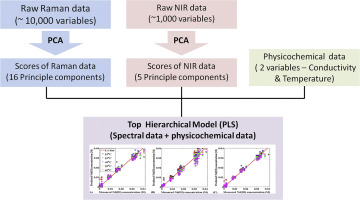当前位置:
X-MOL 学术
›
Anal. Chim. Acta
›
论文详情
Our official English website, www.x-mol.net, welcomes your
feedback! (Note: you will need to create a separate account there.)
Combinations of NIR, Raman spectroscopy and physicochemical measurements for improved monitoring of solvent extraction processes using hierarchical multivariate analysis models
Analytica Chimica Acta ( IF 5.7 ) Pub Date : 2018-05-01 , DOI: 10.1016/j.aca.2017.12.019 Ko Nee , Samuel A. Bryan , Tatiana G. Levitskaia , Jennifer W.-J. Kuo , Mikael Nilsson
Analytica Chimica Acta ( IF 5.7 ) Pub Date : 2018-05-01 , DOI: 10.1016/j.aca.2017.12.019 Ko Nee , Samuel A. Bryan , Tatiana G. Levitskaia , Jennifer W.-J. Kuo , Mikael Nilsson

|
The reliability of chemical processes can be greatly improved by implementing inline monitoring systems. Combining multivariate analysis with non-destructive sensors can enhance the process without interfering with the operation. We present here hierarchical models using both principal component analysis and partial least square analysis developed for different chemical components representative of solvent extraction process streams. A training set of 380 samples and an external validation set of 95 samples were prepared and Near infrared and Raman spectral data as well as conductivity under variable temperature conditions were collected. The results from the models indicate that careful selection of the spectral range is important. By compressing the data through Principal Component Analysis (PCA), we lower the rank of the data set to its most dominant features while maintaining the key principal components to be used in the regression analysis. Within the studied data set, concentration of five chemical components were modeled; total nitrate (NO3-), total acid (H+), neodymium (Nd3+), sodium (Na+), and ionic strength (I.S.). The best overall model prediction for each of the species studied used a combined data set comprised of complementary techniques including NIR, Raman, and conductivity. Our study shows that chemometric models are powerful but requires significant amount of carefully analyzed data to capture variations in the chemistry.
中文翻译:

NIR、拉曼光谱和物理化学测量的组合使用分层多变量分析模型改进对溶剂萃取过程的监测
通过实施在线监测系统,可以大大提高化学过程的可靠性。将多变量分析与无损传感器相结合,可以在不干扰操作的情况下增强过程。我们在这里介绍了使用主成分分析和偏最小二乘分析为代表溶剂萃取工艺流的不同化学成分开发的分层模型。准备了 380 个样本的训练集和 95 个样本的外部验证集,并收集了近红外和拉曼光谱数据以及可变温度条件下的电导率。模型的结果表明仔细选择光谱范围很重要。通过主成分分析 (PCA) 压缩数据,我们将数据集的排名降低到其最主要的特征,同时保留用于回归分析的关键主成分。在研究的数据集中,对五种化学成分的浓度进行了建模;总硝酸盐 (NO3-)、总酸 (H+)、钕 (Nd3+)、钠 (Na+) 和离子强度 (IS)。对所研究的每个物种的最佳整体模型预测使用了一个组合数据集,该数据集由包括 NIR、拉曼和电导率在内的互补技术组成。我们的研究表明,化学计量学模型是强大的,但需要大量仔细分析的数据来捕捉化学变化。总硝酸盐 (NO3-)、总酸 (H+)、钕 (Nd3+)、钠 (Na+) 和离子强度 (IS)。对所研究的每个物种的最佳整体模型预测使用了一个组合数据集,该数据集由包括 NIR、拉曼和电导率在内的互补技术组成。我们的研究表明,化学计量学模型是强大的,但需要大量仔细分析的数据来捕捉化学变化。总硝酸盐 (NO3-)、总酸 (H+)、钕 (Nd3+)、钠 (Na+) 和离子强度 (IS)。对所研究的每个物种的最佳整体模型预测使用了一个组合数据集,该数据集由包括 NIR、拉曼和电导率在内的互补技术组成。我们的研究表明,化学计量学模型是强大的,但需要大量仔细分析的数据来捕捉化学变化。
更新日期:2018-05-01
中文翻译:

NIR、拉曼光谱和物理化学测量的组合使用分层多变量分析模型改进对溶剂萃取过程的监测
通过实施在线监测系统,可以大大提高化学过程的可靠性。将多变量分析与无损传感器相结合,可以在不干扰操作的情况下增强过程。我们在这里介绍了使用主成分分析和偏最小二乘分析为代表溶剂萃取工艺流的不同化学成分开发的分层模型。准备了 380 个样本的训练集和 95 个样本的外部验证集,并收集了近红外和拉曼光谱数据以及可变温度条件下的电导率。模型的结果表明仔细选择光谱范围很重要。通过主成分分析 (PCA) 压缩数据,我们将数据集的排名降低到其最主要的特征,同时保留用于回归分析的关键主成分。在研究的数据集中,对五种化学成分的浓度进行了建模;总硝酸盐 (NO3-)、总酸 (H+)、钕 (Nd3+)、钠 (Na+) 和离子强度 (IS)。对所研究的每个物种的最佳整体模型预测使用了一个组合数据集,该数据集由包括 NIR、拉曼和电导率在内的互补技术组成。我们的研究表明,化学计量学模型是强大的,但需要大量仔细分析的数据来捕捉化学变化。总硝酸盐 (NO3-)、总酸 (H+)、钕 (Nd3+)、钠 (Na+) 和离子强度 (IS)。对所研究的每个物种的最佳整体模型预测使用了一个组合数据集,该数据集由包括 NIR、拉曼和电导率在内的互补技术组成。我们的研究表明,化学计量学模型是强大的,但需要大量仔细分析的数据来捕捉化学变化。总硝酸盐 (NO3-)、总酸 (H+)、钕 (Nd3+)、钠 (Na+) 和离子强度 (IS)。对所研究的每个物种的最佳整体模型预测使用了一个组合数据集,该数据集由包括 NIR、拉曼和电导率在内的互补技术组成。我们的研究表明,化学计量学模型是强大的,但需要大量仔细分析的数据来捕捉化学变化。











































 京公网安备 11010802027423号
京公网安备 11010802027423号